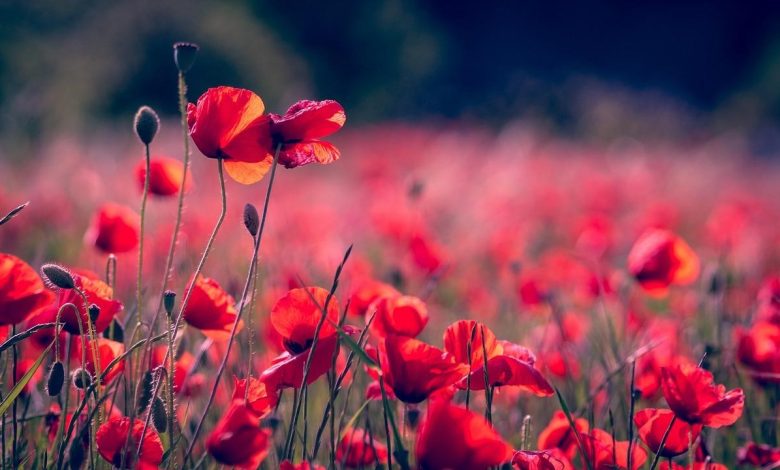The Poppy Flower: A Symbol of Beauty and Remembrance

With its vibrant colors and delicate petals, the poppy flower has captivated the hearts of people around the world. This stunning bloom, belonging to the Papaveraceae family, is known for its symbolism, cultural significance, and diverse species. From its role in art and literature to its association with remembrance, the poppy flower continues to inspire and evoke a sense of awe.
Read About: Care of Lilium Candidum
The poppy flower Is native to various parts of the world, including Europe, Asia, and North America. It is an annual, herbaceous plant that thrives in sunny environments and well-drained soil. Depending on the species, poppies can grow to various heights, ranging from a few inches to several feet. The most common species include the Oriental poppy (Papaver orientale), the California poppy (Eschscholzia californica), and the opium poppy (Papaver somniferum).
Characteristics of poppy flower
One of the most iconic characteristics of the poppy flower is its striking colors. The petals come in various shades, including vibrant red, pink, orange, yellow, and even white. The delicate, papery texture of the petals adds to their ethereal beauty. Poppies often have a dark center, which is adorned with a cluster of contrasting stamens. This unique combination of colors and textures makes the poppy flower a favorite subject for artists, photographers, and gardeners alike.
The Cultural Significance of Poppy Flowers
Throughout history, the poppy flower has held cultural and symbolic significance in different societies. In ancient Greek and Roman mythology, poppies were associated with sleep and dreams. The opium poppy, in particular, played a prominent role in medicinal practices and rituals. In Asian cultures, the poppy flower symbolizes beauty, success, and fertility. In China, it is a popular motif in traditional art and often represents love and passion.
One of the most significant associations of the poppy flower is with remembrance. This connection stems from the powerful poem “In Flanders Fields” by Lieutenant Colonel John McCrae, written during World War I. The poem describes the poppies that grew in the battlefields of Flanders, where countless soldiers lost their lives. The image of red poppies swaying among the graves became a poignant symbol of the sacrifices made by soldiers in war. Today, the red poppy is worn as a commemorative symbol on Remembrance Day in many countries. If you are looking for best vpn for your iphone you can read our new blog how to turn off vpn on iphone
Poppy Flower Uses: Medicinal & Culinary
Poppy flowers have been used for various medicinal and culinary purposes for centuries. Here are some of the notable uses of poppy flowers in both domains:
Medicinal Uses:
Pain Relief:
Poppy flowers contain alkaloids such as morphine and codeine, which are potent pain relievers. These compounds are commonly used in the production of pain medications.
Sedation and Sleep Aid:
Opium extracted from poppy flowers has been used traditionally as a sedative and sleep aid. It helps induce relaxation and can be used to alleviate anxiety and promote restful sleep.
Cough Suppressant:
Codeine, derived from poppy flowers, is often used as a cough suppressant due to its ability to reduce the urge to cough. It is commonly found in cough syrup formulations.
Antidiarrheal Properties:
Poppy flowers contain morphine, which can help relieve severe cases of diarrhea by reducing bowel movement and enhancing water absorption in the intestines.
Culinary Uses:
Poppy Seed:
Poppy seeds obtained from mature poppy pods are commonly used in baking and cooking. They have a nutty flavor and are used in pastries, bread, cakes, and as a topping for bagels. They can also be ground into a paste to make traditional dishes like poppy seed filling for rolls.
Poppy Flower Petals:
The vibrant and delicate petals of poppy flowers are sometimes used in salads, as a garnish, or added to stir-fries to add color and a subtle floral note to dishes. However, it’s important to note that some varieties of poppy flowers may contain opium alkaloids and should not be consumed in large quantities.
Poppy Syrup:
In some cultures, poppy flowers are used to make a syrup that can be drizzled over desserts or used as a sweetener. The syrup is made by extracting the juice from the petals and then boiling it down with sugar to create a thick, fragrant syrups
It’s Important to exercise caution and be aware of the legal and regulatory aspects related to the use of poppy flowers, especially in medicinal applications. Many countries have strict regulations surrounding the cultivation, extraction, and use of opium alkaloids derived from poppy flowers due to their potential for abuse and addiction.
Conclusion
The poppy flower is much more than just a beautiful blossom. Its vibrant colors, delicate petals, and diverse species have made it a beloved symbol across cultures. Whether as a source of inspiration for artists, a commemorative emblem, a medicinal plant, or a culinary ingredient, the poppy flowers continues to captivate and enrich our lives. Its timeless beauty and profound symbolism remind us of the power of nature and the human spirit.


